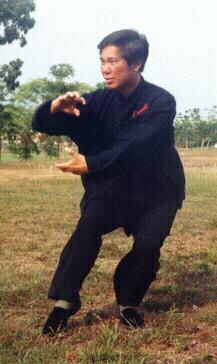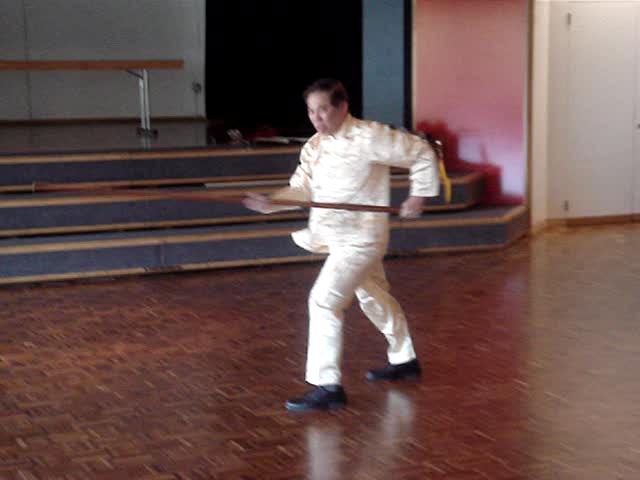LOHAN FIST IS THE BASE OF ALL SHAOLIN STYLES

The dragon style of Shaolin Kungfu, though it may look very different due to its long evolution, evolved from the Eighteen Lohan Fist
Question
Lohanquan is considered the "base" for many kung fu systems, like Eagle Claw, Praying Mantis, and Baguazhang. What is it about Lohanquan that made it so popular and useful for other systems to "build" upon?
For what types of fighting was Lohanquan developed to handle, eg mass fighting, one versus many, one versus one, protecting someone as a bodyguard, etc.?
Is Lohanquan particularly well known for certain weapons? If so, how do Lohanquan and those weapons enhance and complement one another?
Fred Chu, USA
Answer
Lohanquan or Lohan Kungfu is not only the base of many kungfu systems, it can also be said to be the base of all martial arts. Lohan Kungfu is the base of Shaolin Kungfu, i.e. Shaolin Kungfu evolved from Lohan Kungfu, and the techniques of all other martail arts or sports, including wrestling and pin-downs, can be found in Shaolin Kungfu.
The feature that makes Lohan Kungfu so popular and useful for other systems to build upon is footwork or “mabu”, i.e. its stances and movement. We are so used to stances that it may be easy to forget that using appropriate stances was a great leap forward in combat efficiency from random untrained leg movements.
I can speak from direct experience. Looking back at my younger days when I sparred frequently and sometimes actually fought, if I have to pin-point the factor that enabled me to beat my opponents, it was not my techniques, not my force and not my strategies, but my footwork! Had I not spent much time in my stance training I would not have the advantages I had to beat my opponents.
What advantages my footwork gave me over my opponents? I had the advantages of spacing and timing. In other words, by using my stances well I could place myself in favorable positions faster than my opponents escaped from their unfavorable positions so that even when my techniques were mediocre, my force ordinary, and without the use of any strategies, I could defeat my opponents.
For example, when a Karate exponent executed some powerful punches, because I had a good Bow-Arrow Stance and could use it well, I did not have to move my feet away. I just sank back my body, without moving my feet, to avoid his powerful punches, covered them with one hand and simultaneously attacked him with my other hand in a tiger-claw using the pattern “Hungry Tiger Catches Goat”.
If a Taekwondo exponent gave me a side-kick, I would, without moving my feet, sink back in my sideways Bow-Arrow Stance to let the kick pass, then shift my body forward to strike him while he tried to recover his balance after his kick. Because of my skillful use of my stances, even if my actual speed was slower than their, I could still hit them before they could recover their initial attack to defend themselves against my counters.
If my opponents tried to move away from my counters, they would have to use two or three steps, but I could cover the same space in just one step. In ordinary circumstances they could defend against my counters, but my footwork gave me such advantages of spacing and timing that put them in disadvantages positions. Even when they knew the defence against my attacks, they could not effectively defend themselves due to their unfavorable positions.
It is worthy of note that my techniques then were mediocre, my internal force was nothing compared to what it is now, and I knew little or no strategies. Yet, with the advantages of spacing and timing brought about by my skillful use of stances, I could remain undefeated even in my early years of sparring and actual fighting.
I must add that there was another factor contributing to why I always won. I fought smart. I studied my opponents and knew their strengths and weaknesses before sparring with them. But still it was my footwork that gave me practical victory. Without my skillful footwork, even when I theoretical knew my opponents’ strengths and weaknesses, I would not have the advantages of spacing and timing to beat them. This development came later when I started teaching kungfu.
One may argue that fighting smart was a use of strategy. But I was not consciously aware of the strategy then, unlike now I can use strategies or tactics like “leading opponents to futility, and striking them when they are unexpected”, “when there is form strike the form, when there is no form strike the shadow” and “when there is a bridge go along the bridge, when there is no bridge, flow with the water”.
In many ways, my use of footwork to defeat opponents resembles in principles the superiority of Lohan Kungfu over other martial styles. When opponents are mediocre, using Lohan Kungfu gives a big advantage over using other styles. But if the opponents are skillful or sophisticated, Lohan Kungfu in its early version may be inadequate. This setback, however, is not applicable in our school because of our advantage of spread and depth. Besides, the situation today is that most fighters are mediocre, otherwise they would not take being punched and kicked in sparring for granted.
All the three basic stances – namely Horse-Riding, Bow-Arrow and False Leg – were Lohan Kungfu stances. They had been found to be so useful that they had been adopted in all other kungfu styles and many other martial systems. Other stances, like the Goat Stance, the Triangle Stance and the T-Step, were later developments. Kungfu styles like Wuzuquan, Xingyiquan, Praying Mantis and Monkey Style, developed after Lohan Kungfu had been established. Hence, you find that many of the stances in these styles do not use Horse-Riding, Bow-Arrow and False Leg as frequently.
While the stances provide advantages in spacing and timing in combat for the initiated, they become a hindrance to those untrained in them or who do not use them in sparring even when trained in them in solo practice. This is a main reason why many kungfu practitioners are beaten by Boxers and Kick-Boxers bouncing about.
As an analogy, a car provides advantage in spacing and timing in transportation over a bicycle. You are both more comfortable and faster in a car going from place to place. But if you do not know how to drive or do not want to drive, riding a bicycle can enable you to reach your destination but the car would not.
Lohan Kungfu was developed for all types of fighting, including, of course, mass fighting, one versus many, one versus one, and protecting someone as a bodyguard, though Lohan Kungfu practitioners, being Shaolin disciples, might not want to be bodyguards because this profession was not considered noble in Shaolin tradition.
The long range of Lohan Kungfu techniques are effective for mass fighting and one versus many. The powerful pressing movements of Lohan Kungfu are effective for one versus one, especially when the opponent is mediocre.
If all other things were equal, a skillful exponent many exploit the long-range techniques of Lohan Kungfu. But not many exponents have such knowledge and skills. Most exponents would be overwhelmed by the powerful, pressing attacks. Moreover, in Shaolin Wahnam other things are not equal. We have the great advantage of breadth and depth to overcome this setback of Lohan Kungfu.
The staff, especially when it is used as a staff and not as a spear, is particularly well known in Lohan Kungfu. The staff should be heavy, and is mainly used for hitting, not piercing.
Staff techniques and Lohan Kungfu techniques are similar, thus they enhance and complement each other. The often mentioned but seldom seen famous classical staff set of Northern Shaolin, namely Little Night Guard or Xiao Yia Char in Chinese, is excellent for this purpose. Its modern version, called “Five Tigers in a Herd of Sheep”, is widely practiced today in various branches of the Chin Woo Athletic Association, founded by the great Shaolin master, Hou Yuan Jia.

The staff is a well-known weapon in Lohan Kungfu
Little Lohan Fist
18-Lohan Fist
Treasure House of Kungfu Sets
Treasure House of Combat Application
Those who wish to attend the 18-Lohan Fist course in Frankfurt, Germany on 26th, 29th, 30th September and 1st October 2014, please contact Secretary, Wahnam Germany or phone (069) 904-31954.
The questions and answers are reproduced from the thread 10 Questions on 18-Lohan Fist in the Shaolin Wahnam Discussion Forum.
LINKS
